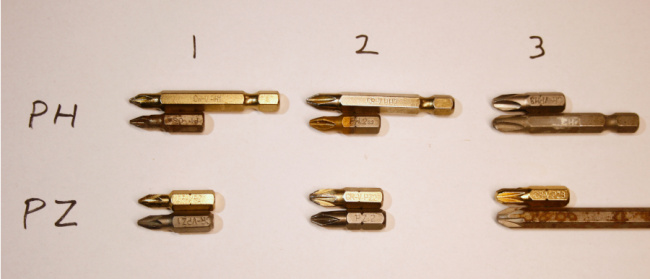Tools and materials
Fasteners and washers
Washers
Screw drives
Philips head and Pozidriv

The Phillips screw drive (often marked PH on screw bits), designed in 1932, was once the typical variant of the cross-shaped screw.
They were designed as an improvement to flat-head (slotted) screws. Flat head would cam out fairly easily, slip, need some alignment. ...more so around smaller screws and around power tools.
At the same time, phillips too will cam out fairly easily (more so if you get the wrong size), a little more so than most other cross-style designs designed since. (There is a theory this was intentional, to avoid overfastening, or save power tools / bits where there was no torque-based ratcheting, but neither of these seems true(verify))
Pozidriv (often marked PZ on screw bits), designed around 1960s, is a different design, from a different company.
Compard to PH, PZ will do a little more torque before it cams.
To this day is often confused with PH. You can identify
- PZ bits/heads by the extra protrusions things between the four main wings
- PZ screws by marker slits between the actual slots
It seems many types of modern DIY screws are pozidriv,
though there are also modern cases that use Philips.
On using the wrong size PH or PZ
For both, size 2 seems to be most common for around-the-house screws, and sometimes a 3 for noticeably beefier screws.
On mixing PH an PZ
If you need minimal torque, then you can get away with treating PZ as PH, or PH as PZ, but neither is ideal.
- PH driver in PZ screws will loosely fit, but slip and cam out once you try to apply more torque, damaging screws and your bits.
- PZ drivers in PH screws will generally not go as deep, so also cam out more easily
https://en.wikipedia.org/wiki/List_of_screw_drives#Phillips
Other cross types
Robertson
See also
https://en.wikipedia.org/wiki/List_of_screw_drives
Tools
Saws
Miter saw
A miter is and angled joint[1].
A miter saw (or mitre saw) helps such joints -- and anything else that is served by well controlled angles
Classically this was mechanical:
- miter box
- wood with slits that guide 90 and 45 degree angles
- to use a regular handsaw in
- the most basic thing you could call 'miter saw' is a handsaw guided by a mechanical mount
- (and replacable blade)
- preferable in that miter boxes tend to degrade with use, so this is more reusable and more precise
Power miter saws are the variants that are motorized, mainly:
- standard miter saw
- brings down a saw head, at a controlled angle.
- (a chop saw is this without the angle control, always cutting right, 90 degree angles)
- compound miter saw
- adds tilt of the head
- (sometimes the basic rotation may be a little more aribitrary/controlles than in a basic variant)
Options / details:
- sliding miter saw (on a compound or standard miter saw)
- sawblade extends on a sliding rail, rather than only being brought down
- can deal with somewhat larger boards
- ability to angle to both sides rather than one (and, less commonly, to tilt to both sides)
- easier to do certain cuts readjusting the saw rather repositioning than the workpiece
- LED/laser
- a little more precision
Because this is a collection of features realized in different combinations
- some may be unique to areas (or industries)
- and may have specific names in some areas of the world that they do not have in others.
Circular saw
Sort of like a table saw without a table.
Generally for wood, though variations for e.g. metal and concrete may vary in design, not just mounting a different blade.